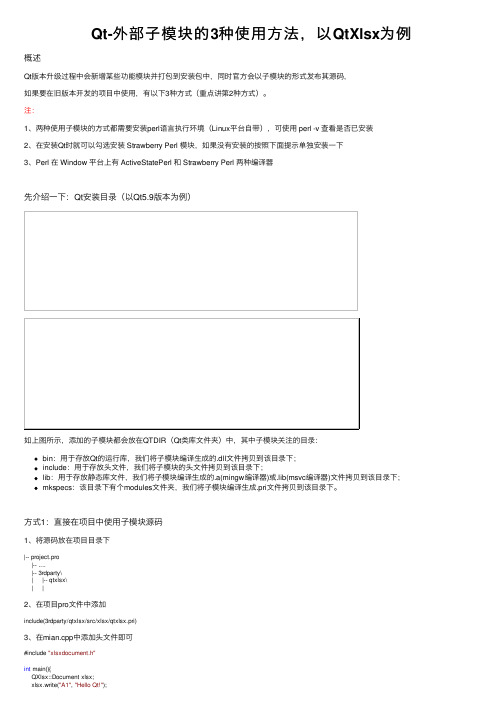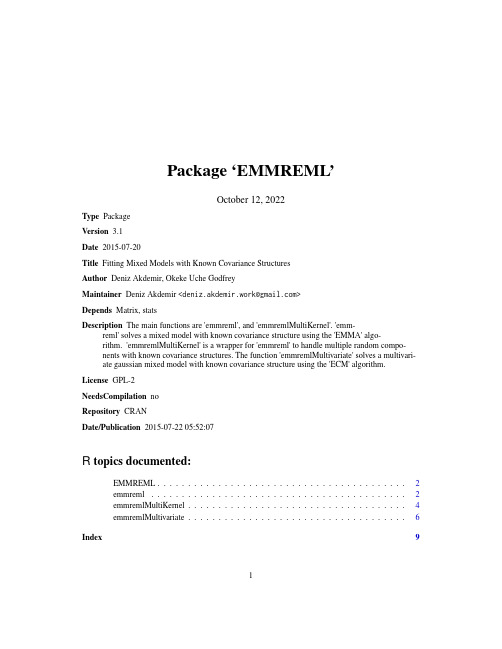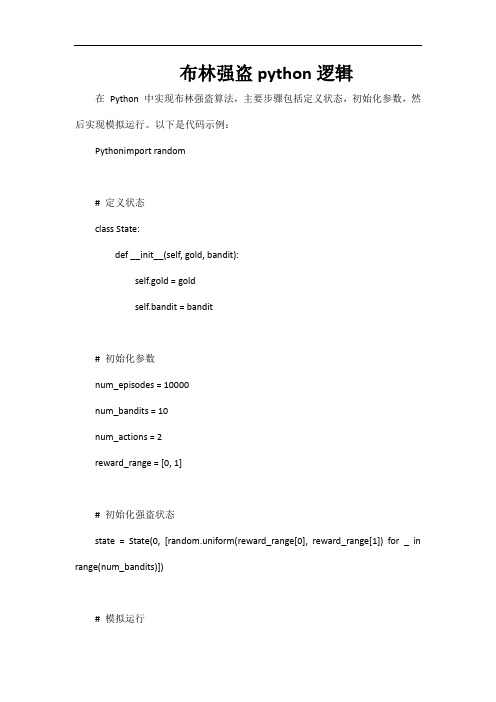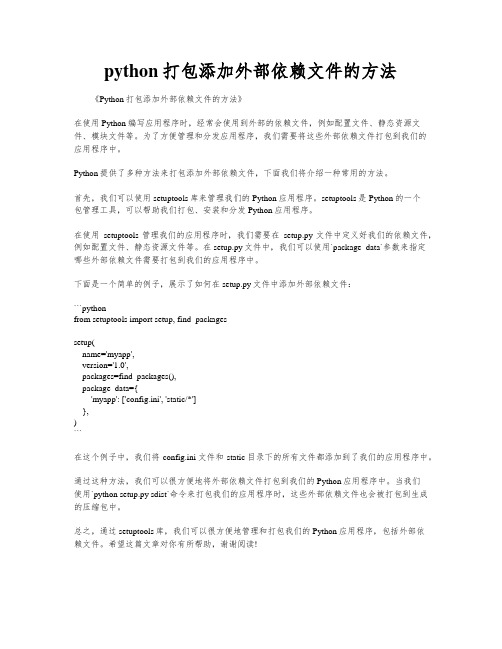$Q^2$-dependence of backward pion multiplicity in neutrino-nucleus interactions
formitem dependencies 用法

formitem dependencies 用法在开发Web表单时,我们经常会遇到一种情况:表单中某些字段的可用性或显示状态依赖于其他字段的值。
为了解决这个问题,我们可以使用formitem dependencies(表单项依赖关系)来实现相关字段之间的依赖性。
formitem dependencies是一种前端技术,通过在表单项上定义依赖关系,可以自动检测和处理相关字段之间的依赖关系。
当相关字段的值发生变化时,被依赖的字段可以根据预先定义的规则来更新其状态或可用性。
具体来说,我们可以通过在表单项上添加"dependencies"属性来定义依赖关系。
这个属性是一个对象,其中键是被依赖字段的名称,值是一个数组,表示该字段的值需要满足的条件。
例如,假设我们有一个注册表单,其中包含用户名和密码两个字段。
用户名字段的可用性应该依赖于密码字段的长度是否大于6。
我们可以这样定义表单项的依赖关系:```html<FormItem><Input name="password" type="password" /></FormItem><FormItem dependencies={{ password: [{ value: 6, operator: 'gt', message: '密码必须大于6个字符' }] }}><Input name="username" /></FormItem>```在上面的示例中,我们将密码字段名("password")定义为用户名字段("username")的依赖项。
通过设置密码字段的dependencies属性为一个对象,指定了一个条件:密码字段的值必须大于6个字符。
Qt-外部子模块的3种使用方法,以QtXlsx为例

Qt-外部⼦模块的3种使⽤⽅法,以QtXlsx为例概述Qt版本升级过程中会新增某些功能模块并打包到安装包中,同时官⽅会以⼦模块的形式发布其源码,如果要在旧版本开发的项⽬中使⽤,有以下3种⽅式(重点讲第2种⽅式)。
注:1、两种使⽤⼦模块的⽅式都需要安装perl语⾔执⾏环境(Linux平台⾃带),可使⽤ perl -v 查看是否已安装2、在安装Qt时就可以勾选安装 Strawberry Perl 模块,如果没有安装的按照下⾯提⽰单独安装⼀下3、Perl 在 Window 平台上有 ActiveStatePerl 和 Strawberry Perl 两种编译器先介绍⼀下:Qt安装⽬录(以Qt5.9版本为例)如上图所⽰,添加的⼦模块都会放在QTDIR(Qt类库⽂件夹)中,其中⼦模块关注的⽬录:bin:⽤于存放Qt的运⾏库,我们将⼦模块编译⽣成的.dll⽂件拷贝到该⽬录下;include:⽤于存放头⽂件,我们将⼦模块的头⽂件拷贝到该⽬录下;lib:⽤于存放静态库⽂件,我们将⼦模块编译⽣成的.a(mingw编译器)或.lib(msvc编译器)⽂件拷贝到该⽬录下;mkspecs:该⽬录下有个modules⽂件夹,我们将⼦模块编译⽣成.pri⽂件拷贝到该⽬录下。
⽅式1:直接在项⽬中使⽤⼦模块源码1、将源码放在项⽬⽬录下|-- project.pro|-- ....|-- 3rdparty\| |-- qtxlsx\| |2、在项⽬pro⽂件中添加include(3rdparty/qtxlsx/src/xlsx/qtxlsx.pri)3、在mian.cpp中添加头⽂件即可#include "xlsxdocument.h"int main(){QXlsx::Document xlsx;xlsx.write("A1", "Hello Qt!");xlsx.saveAs("Test.xlsx");return0;}⽅式2:编译⼦模块源码并将其添加为Qt的⼦模块(以QtXlsx为例)我们只需要下载这个⼦模块的源码进⾏编译并安装到开发环境中即可。
qabstractitemmodel使用

qabstractitemmodel使用介绍qabstractitemmodel是Qt中一个重要的类,用于在Qt应用程序中管理数据的模型。
它是Qt中模型/视图编程的核心组件之一。
通过使用qabstractitemmodel,我们可以将数据进行组织、展示和修改,并将其与视图部件(如QTreeView和QTableView)进行连接。
在本文中,我们将深入探讨qabstractitemmodel的使用方法和功能。
我们将介绍如何创建和使用qabstractitemmodel的子类,以及如何使用它来管理数据。
创建qabstractitemmodel的子类要使用qabstractitemmodel,我们首先需要创建一个继承自qabstractitemmodel 的子类。
这个子类将负责实现我们需要的数据模型。
创建子类时,我们需要至少实现以下几个方法:rowCount和columnCount这两个方法分别用于返回模型中的行数和列数。
在子类中,我们需要根据我们的数据来实现这两个方法。
例如,如果我们的数据是一个二维表格,则rowCount方法应该返回表格的行数,而columnCount方法应该返回表格的列数。
datadata方法用于返回给定索引的数据。
在子类中,我们需要根据索引指定的行和列来实现此方法。
例如,如果我们的数据是一个二维表格,则data方法应该返回表格中对应索引的数据。
setDatasetData方法用于设置给定索引的数据。
在子类中,我们需要根据索引指定的行和列以及新的数据来实现此方法。
例如,如果我们的数据是一个二维表格,则setData方法应该将新数据设置到表格中对应索引的位置。
index和parent这两个方法用于返回给定行和列的索引以及给定索引的父级索引。
在子类中,我们需要根据行和列来实现index方法,并根据索引的父级关系来实现parent方法。
这些方法是构建模型中索引的基础。
flagsflags方法用于返回给定索引的标志。
EMMREML软件说明说明书

Package‘EMMREML’October12,2022Type PackageVersion3.1Date2015-07-20Title Fitting Mixed Models with Known Covariance StructuresAuthor Deniz Akdemir,Okeke Uche GodfreyMaintainer Deniz Akdemir<****************************>Depends Matrix,statsDescription The main functions are'emmreml',and'emmremlMultiKernel'.'emm-reml'solves a mixed model with known covariance structure using the'EMMA'algo-rithm.'emmremlMultiKernel'is a wrapper for'emmreml'to handle multiple random compo-nents with known covariance structures.The function'emmremlMultivariate'solves a multivari-ate gaussian mixed model with known covariance structure using the'ECM'algorithm. License GPL-2NeedsCompilation noRepository CRANDate/Publication2015-07-2205:52:07R topics documented:EMMREML (2)emmreml (2)emmremlMultiKernel (4)emmremlMultivariate (6)Index91EMMREML Fitting mixed models with known covariance structures.DescriptionThe main functions are emmreml,and emmremlMultiKernel.emmreml solves a mixed model with known covariance structure using the EMMA algorithm in Kang et.al.(2008).emmremlMulti-Kernel is a wrapper for emmreml to handle multiple random components with known covariance structures.The function emmremlMultivariate solves a multivariate gaussian mixed model with known covariance structure using the ECM algorithm in Zhou and Stephens(2012).DetailsPackage:EMMREMLType:PackageVersion: 3.1Date:2015-07-20License:GPL-2Author(s)Deniz Akdemir,Okeke Uche GodfreyMaintainer:Deniz Akdemir<****************************>ReferencesEfficient control of population structure in model organism association mapping.Kang,Hyun Min and Zaitlen,Noah A and Wade,Claire M and Kirby,Andrew and Heckerman,David and Daly, Mark J and Eskin,Eleazar.Genetics,2008.Genome-wide efficient mixed-model analysis for association studies.Zhou,Xiang and Stephens, Matthew.Nature genetics,2012.emmreml Solver for Gaussian mixed model with known covariance structure.DescriptionThis function estimates the parameters of the modely=Xβ+Zu+ewhere y is the n vector of response variable,X is a nxq known design matrix offixed effects,Z isa nxl known design matrix of random effects,βis qx1vector offixed effects coefficients and u ande are independent variables with N l(0,σ2u K)and N n(0,σ2e I n)correspondingly.It also producesthe BLUPs and some other useful statistics like large sample estimates of variances and PEV.Usageemmreml(y,X,Z,K,varbetahat=FALSE,varuhat=FALSE,PEVuhat=FALSE,test=FALSE)Argumentsy nx1numeric vectorX nxq matrixZ nxl matrixK lxl matrix of known relationshipsvarbetahat TRUE or FALSEvaruhat TRUE or FALSEPEVuhat TRUE or FALSEtest TRUE or FALSEValueVu Estimate ofσ2uVe Estimate ofσ2ebetahat BLUEs forβuhat BLUPs for uXsqtestbetaχ2test statistics for testing whether thefixed effect coefficients are equal to zero.pvalbeta pvalues obtained from large sample theory for thefixed effects.We report the pvalues adjusted by the"padjust"function for allfixed effect coefficients.Xsqtestuχ2test statistic values for testing whether the BLUPs are equal to zero.pvalu pvalues obtained from large sample theory for the BLUPs.We report the pvalues adjusted by the"padjust"function.varuhat Large sample variance for the BLUPs.varbetahat Large sample variance for theβ’s.PEVuhat Prediction error variance estimates for the BLUPs.loglik loglikelihood for the model.Examplesn=200M1<-matrix(rnorm(n*300),nrow=n)K1<-cov(t(M1))K1=K1/mean(diag(K1))covY<-2*K1+1*diag(n)Y<-10+crossprod(chol(covY),rnorm(n))#training setTrainset<-sample(1:n,150)funout<-emmreml(y=Y[Trainset],X=matrix(rep(1,n)[Trainset],ncol=1),Z=diag(n)[Trainset,],K=K1)cor(Y[-Trainset],funout$uhat[-Trainset])emmremlMultiKernel Function tofit Gaussian mixed model with multiple mixed effects withknown covariances.DescriptionThis function is a wrapper for the emmreml tofit Gaussian mixed model with multiple mixed effects with known covariances.The modelfitted is y=Xβ+Z1u1+Z2u2+...Z k u k+e where y is the n vector of response variable,X is a nxq known design matrix offixed ef-fects,Z j is a nxl j known design matrix of random effects for j=1,2,...,k,βis nx1vec-tor offixed effects coefficients and U=(u t1,u t2,...,u tk )t and e are independent variables withN L(0,blockdiag(σ2u1K1,σ2u2K2,...,σ2ukK k))and N n(0,σ2e I n)correspondingly.The function pro-duces the BLUPs for the L=l1+l2+...+l k dimensional random effect U.The variance parameters for random effects are estimated as(ˆw1,ˆw2,...,ˆw k)∗ˆσ2u where w=(w1,w2,...,w k)are the kernel weights.The function also provides some useful statistics like large sample estimates of variances and PEV.UsageemmremlMultiKernel(y,X,Zlist,Klist,varbetahat=FALSE,varuhat=FALSE,PEVuhat=FALSE,test=FALSE)Argumentsy nx1numeric vectorX nxq matrixZlist list of random effects design matrices of dimensions nxl1,...,nxl kKlist list of known relationship matrices of dimensions l1xl1,...,l k xl kvarbetahat TRUE or FALSEvaruhat TRUE or FALSEPEVuhat TRUE or FALSEtest TRUE or FALSEValueVu Estimate ofσ2uVe Estimate ofσ2ebetahat BLUEs forβuhat BLUPs for uweights Estimates of kernel weightsXsqtestbeta Aχ2test statistic based for testing whether thefixed effect coefficients are equal to zero.pvalbeta pvalues obtained from large sample theory for thefixed effects.We report the pvalues adjusted by the"padjust"function for allfixed effect coefficients.Xsqtestu Aχ2test statistic based for testing whether the BLUPs are equal to zero.pvalu pvalues obtained from large sample theory for the BLUPs.We report the pvalues adjusted by the"padjust"function.varuhat Large sample variance for the BLUPs.varbetahat Large sample variance for theβ’s.PEVuhat Prediction error variance estimates for the BLUPs.loglik loglikelihood for the model.Examples####example#Data from Gaussian process with three#(total four,including residuals)independent#sources of variationn=80M1<-matrix(rnorm(n*10),nrow=n)M2<-matrix(rnorm(n*20),nrow=n)M3<-matrix(rnorm(n*5),nrow=n)#Relationship matricesK1<-cov(t(M1))K2<-cov(t(M2))K3<-cov(t(M3))K1=K1/mean(diag(K1))K2=K2/mean(diag(K2))K3=K3/mean(diag(K3))#Generate datacovY<-2*(.2*K1+.7*K2+.1*K3)+diag(n)Y<-10+crossprod(chol(covY),rnorm(n))#training setTrainsamp<-sample(1:80,60)funout<-emmremlMultiKernel(y=Y[Trainsamp],X=matrix(rep(1,n)[Trainsamp],ncol=1),Zlist=list(diag(n)[Trainsamp,],diag(n)[Trainsamp,],diag(n)[Trainsamp,]),Klist=list(K1,K2,K3),varbetahat=FALSE,varuhat=FALSE,PEVuhat=FALSE,test=FALSE)#weightsfunout$weights#Correlation of predictions with true values in test setuhatmat<-matrix(funout$uhat,ncol=3)uhatvec<-rowSums(uhatmat)cor(Y[-Trainsamp],uhatvec[-Trainsamp])emmremlMultivariate Function tofit multivariate Gaussian mixed model with with knowncovariance structure.DescriptionThis function estimates the parameters of the modelY=BX+GZ+Ewhere Y is the dxn matrix of response variable,X is a qxn known design matrix offixed effects, Z is a lxn known design matrix of random effects,B is dxq matrix offixed effects coefficients and G and E are independent matrix variate variables with N dxl(0,V G,K)and N dxn(0,V E,I n) correspondingly.It also produces the BLUPs for the random effects G and some other statistics. UsageemmremlMultivariate(Y,X,Z,K,varBhat=FALSE,varGhat=FALSE,PEVGhat=FALSE,test=FALSE,tolpar=1e-06,tolparinv=1e-06)ArgumentsY dxn matrix of response variableX qxn known design matrix offixed effectsZ lxn known design matrix of random effectsK lxl matrix of known relationshipsvarBhat TRUE or FALSEvarGhat TRUE or FALSEPEVGhat TRUE or FALSEtest TRUE or FALSEtolpar tolerance parameter for convergencetolparinv tolerance parameter for matrix inverseValueVg Estimate of V GVe Estimate of V EBhat BLUEs for BGpred BLUPs for GXsqtestBχ2test statistics for testing whether thefixed effect coefficients are equal to zero.pvalB pvalues obtained from large sample theory for thefixed effects.We report the pvalues adjusted by the"padjust"function for allfixed effect coefficients.XsqtestGχ2test statistic values for testing whether the BLUPs are equal to zero.pvalG pvalues obtained from large sample theory for the BLUPs.We report the pvalues adjusted by the"padjust"function.varGhat Large sample variance for BLUPs.varBhat Large sample variance for the elements of B.PEVGhat Prediction error variance estimates for the BLUPs.Examplesl=20n<-15m<-40M<-matrix(rbinom(m*l,2,.2),nrow=l)rownames(M)<-paste("l",1:nrow(M))beta1<-rnorm(m)*exp(rbinom(m,5,.2))beta2<-rnorm(m)*exp(rbinom(m,5,.1))beta3<-rnorm(m)*exp(rbinom(m,5,.1))+beta2g1<-M%*%beta1g2<-M%*%beta2g3<-M%*%beta3e1<-sd(g1)*rnorm(l)e2<-(-e1*2*sd(g2)/sd(g1)+.25*sd(g2)/sd(g1)*rnorm(l))e3<-1*(e1*.25*sd(g2)/sd(g1)+.25*sd(g2)/sd(g1)*rnorm(l))y1<-10+g1+e1y2<--50+g2+e2y3<--5+g3+e3Y<-rbind(t(y1),t(y2),t(y3))colnames(Y)<-rownames(M)cov(t(Y))Y[1:3,1:5]K<-cov(t(M))K<-K/mean(diag(K))rownames(K)<-colnames(K)<-rownames(M)X<-matrix(1,nrow=1,ncol=l)colnames(X)<-rownames(M)Z<-diag(l)rownames(Z)<-colnames(Z)<-rownames(M)SampleTrain<-sample(rownames(Z),n)Ztrain<-Z[rownames(Z)%in%SampleTrain,]Ztest<-Z[!(rownames(Z)%in%SampleTrain),]##For a quick answer,tolpar is set to1e-4.Correct this in practice.outfunc<-emmremlMultivariate(Y=Y%*%t(Ztrain),X=X%*%t(Ztrain),Z=t(Ztrain),K=K,tolpar=1e-4,varBhat=FALSE,varGhat=FALSE,PEVGhat=FALSE,test=FALSE)Yhattest<-outfunc$Gpred%*%t(Ztest)cor(cbind(Ztest%*%Y[1,],Ztest%*%outfunc$Gpred[1,],Ztest%*%Y[2,],Ztest%*%outfunc$Gpred[2,],Ztest%*%Y[3,],Ztest%*%outfunc$Gpred[3,])) outfuncRidgeReg<-emmremlMultivariate(Y=Y%*%t(Ztrain),X=X%*%t(Ztrain),Z=t(Ztrain%*%M), K=diag(m),tolpar=1e-5,varBhat=FALSE,varGhat=FALSE,PEVGhat=FALSE,test=FALSE)Gpred2<-outfuncRidgeReg$Gpred%*%t(M)cor(Ztest%*%Y[1,],Ztest%*%Gpred2[1,])cor(Ztest%*%Y[2,],Ztest%*%Gpred2[2,])cor(Ztest%*%Y[3,],Ztest%*%Gpred2[3,])IndexEMMREML,2emmreml,2emmremlMultiKernel,4 emmremlMultivariate,69。
布林强盗python逻辑

布林强盗python逻辑在Python 中实现布林强盗算法,主要步骤包括定义状态,初始化参数,然后实现模拟运行。
以下是代码示例:Pythonimport random# 定义状态class State:def __init__(self, gold, bandit):self.gold = goldself.bandit = bandit# 初始化参数num_episodes = 10000num_bandits = 10num_actions = 2reward_range = [0, 1]# 初始化强盗状态state = State(0, [random.uniform(reward_range[0], reward_range[1]) for _ in range(num_bandits)])# 模拟运行for episode in range(num_episodes):# 选择行动action = random.randint(0, num_actions - 1)# 获取奖励reward = state.bandit[action]# 更新状态new_state = State(state.gold + reward, [reward if i == action else state.bandit[i] for i in range(num_bandits)])# 打印状态和行动print(f"State: {state}, Action: {action}, Reward: {reward}, New State: {new_state}")state = new_state # 更新状态为新的状态这个代码实现了一个简单的布林强盗算法,模拟了强盗选择一个bandit(强盗的藏匿点)并获得奖励的过程。
在每个episode(一轮),强盗随机选择一个bandit,然后获得该bandit 的奖励,并更新其状态。
dependency-check 用法

dependency-check 用法下载提示:该文档是本店铺精心编制而成的,希望大家下载后,能够帮助大家解决实际问题。
文档下载后可定制修改,请根据实际需要进行调整和使用,谢谢!本店铺为大家提供各种类型的实用资料,如教育随笔、日记赏析、句子摘抄、古诗大全、经典美文、话题作文、工作总结、词语解析、文案摘录、其他资料等等,想了解不同资料格式和写法,敬请关注!Download tips: This document is carefully compiled by this editor. I hope that after you download it, it can help you solve practical problems. The document can be customized and modified after downloading, please adjust and use it according to actual needs, thank you! In addition, this shop provides you with various types of practical materials, such as educational essays, diary appreciation, sentence excerpts, ancient poems, classic articles, topic composition, work summary, word parsing, copy excerpts, other materials and so on, want to know different data formats and writing methods, please pay attention!使用 dependency-check 的指南介绍在软件开发过程中,安全性是至关重要的一环。
关于二方库依赖的解析命令

关于二方库依赖的解析命令
解析二方库依赖的命令取决于你使用的构建工具和依赖管理系统。
下面是一些常见的构建工具和依赖管理系统的解析命令:
1. Maven:Maven是一个Java项目的构建工具和依赖管理工具。
在Maven中,可以使用以下命令解析二方库依赖:
```
mvn dependency:tree
```
2. Gradle:Gradle是一个通用的构建工具,可以用于Java、Android和其他项目。
在Gradle中,可以使用以下命令解析二
方库依赖:
```
gradle dependencies
```
3. npm:npm是一个用于管理JavaScript包和依赖关系的工具。
在npm中,可以使用以下命令解析二方库依赖:
```
npm list
```
4. pip:pip是Python包管理器,用于安装和管理Python包和
依赖关系。
在pip中,可以使用以下命令解析二方库依赖:
```
pip freeze
```
请注意,这些命令可能会根据使用的工具和配置有所变化。
因此,请查阅相应工具的文档以获取正确的解析命令。
backtrader源码解读

backtrader源码解读backtrader是一个开源的Python框架,用于开发和执行量化交易策略。
它提供了一组易于使用和灵活的工具,用于构建、测试和部署交易策略。
下面是一些backtrader源码的关键解读:1. Cerebro类:Cerebro是backtrader的主要组件之一。
它是一个用于管理交易策略和执行回测的引擎。
在Cerebro类中,有一些关键方法,比如`run()`方法用于执行回测,`addstrategy()`方法用于添加策略,`adddata()`方法用于添加数据源等。
2. Strategy类:Strategy是backtrader中的另一个关键类。
它是一个抽象基类,用于定义和执行交易策略。
在Strategy类中,有一些关键方法,比如`next()`方法用于定义策略信号的生成和执行,`notify_order()`方法用于接收订单执行的通知,`notify_trade()`方法用于接收交易完成的通知等。
3. Indicator类:Indicator是backtrader中用于计算各种技术指标的类。
它提供了一系列内置的指标计算方法,如移动平均线、布林带、相对强弱指标等。
Indicator类主要用于帮助策略计算和分析。
4. Data类:Data类用于处理和管理市场数据。
backtrader支持多种数据源,包括CSV文件、Pandas DataFrame、在线数据源等。
Data类提供了一些方法,如`load()`方法用于加载数据,`resample()`方法用于重新采样数据等。
5. Broker类:Broker类用于模拟和执行交易操作。
backtrader 中提供了一些内置的模拟交易经纪人,如BacktraderBroker和AlpacaBroker等。
Broker类提供了一些方法,如`buy()`方法用于买入股票,`sell()`方法用于卖出股票等。
以上是backtrader源码中的一些关键类和方法的简要解读。
qabstractitemmodel使用

qabstractitemmodel使用QAbstractItemModel使用QAbstractItemModel是Qt中一个重要的类,它是QtModel/View框架的基础。
通过继承QAbstractItemModel,我们可以自定义模型来管理数据,并将数据呈现给用户。
以下是使用QAbstractItemModel的一些要点:1. 继承QAbstractItemModel类要使用QAbstractItemModel,我们需要继承该类并实现其纯虚函数。
这些函数包括rowCount()、columnCount()、data()、index()、parent()等。
2. 实现rowCount()和columnCount()函数这两个函数分别返回模型中的行数和列数。
实现这两个函数时,我们需要考虑数据的实际情况,并返回正确的值。
3. 实现data()函数data()函数用于返回某个索引处的数据。
我们需要根据索引的不同,返回相应的数据。
例如,对于一个表格模型,我们可以返回表格中某个单元格的数据。
4. 实现index()和parent()函数index()函数用于返回某个位置的索引,而parent()函数则返回该索引的父级索引。
这两个函数通常是成对实现的。
5. 实现setData()函数setData()函数用于设置某个索引处的数据。
我们需要在该函数中更新数据,并发出相应的信号以通知视图更新。
6. 实现headerData()函数headerData()函数用于返回表头数据。
我们需要在该函数中返回正确的表头数据。
7. 实现flags()函数flags()函数用于返回某个索引的标志位。
我们需要在该函数中返回正确的标志位,以便视图能够正确地处理该索引。
通过以上步骤,我们可以使用QAbstractItemModel来管理数据,并将数据呈现给用户。
在实际使用中,我们还可以通过使用QTreeView、QTableView等视图类来显示数据。
backtrader源码解析

backtrader源码解析Backtrader是一款Python开源的量化交易框架,具有易于使用、可扩展性强、技术支持好等特点。
它内置了丰富的技术指标库,支持动态回测、数据中心化管理等功能。
以下将为您带来backtrader源码解析。
第一步:导入模块和数据预处理首先,导入模块需要使用backtrader、pandas、numpy。
在数据预处理分别使用pandas和numpy,先将数据进行读取和预处理。
该过程中,需要设置好数据范围,选择从哪里开始到哪里结束。
第二步:策略实现和回测结果展示在该步骤中,需要先定义一个策略类,该类需要继承于backtrader.strategies.Strategy。
在该类中,需要设置好初始化函数、参数、数据、指标、交易逻辑等。
其中,针对每种交易逻辑,需要自定义一个策略类,在该类中再实现买入和卖出两个函数。
在最后,需要将策略类传递给backtrader.Cerebro对象,使它去执行整个策略。
在回测结束后,可以通过api查看回测的结果和细节,例如年化率、夏普比等。
第三步:风险控制和投资管理在实际交易中,风险控制和投资管理是非常重要的。
使用Backtrader,可以实现以下风险控制措施:(1)投资组合分散化:通过分散持仓,减少单一仓位风险;(2)止损订单:限制可能的损失,最大限度保护资金;(3)利润保护:在盈利时,使用止盈订单锁定一部分利润;(4)单个交易金额限制:这个限制将帮助控制获利或稍微减少损失所需的资金数量;(5)投资组合大小限制:一定的限制,以确保投资组合的总价值不超过可用资金。
总结:Backtrader作为一款优秀的量化交易框架,内置大量的技术指标和功能,可以帮助投资者快速开发自己的交易策略。
该框架具有不错的可扩展性和易于使用的特点。
在使用该框架时,建议注意风险控制和投资管理,以保护资金并确保高线性的回报。
python保持原相对位置输出的函数

python保持原相对位置输出的函数在Python中,有时候我们需要按照某种规则对数据进行排序或者筛选,但是我们又希望保持原数据的相对位置关系,即排完序或者筛选后,数据元素之间的相对位置不改变。
为了实现这个目标,我们可以写一个函数,实现保持原相对位置输出的功能。
该函数包含两个参数,一个是需要排序或筛选的数据列表,一个是判断元素是否符合规则的函数,该函数返回True或者False。
```pythondef keep_position(func, data):output = []for i in range(len(data)):if func(data[i]):output.append(data[i])return output```这个函数的实现非常简单,首先定义了一个空列表output,用于存放符合规则的元素。
然后遍历输入数据列表data,对于每一个元素,如果该元素符合规则,就将其添加到输出列表output中。
最后返回输出列表output。
下面是一个使用示例,该示例对一个包含多个单词的字符串列表进行筛选,只保留长度大于2的单词,并保持输出结果的原有相对位置。
输出结果如下所示,可以看到,长度大于2的单词被保留下来,并且它们的相对位置关系没有改变。
```python['cat', 'dog', 'elephant', 'zebra', 'lion', 'giraffe']```总结:在Python中,保持原相对位置输出的函数非常简单,只需要遍历输入数据列表,并将符合规则的元素添加到输出列表中即可。
在实际应用中,该函数可以用于对数据进行排序、筛选、过滤等操作,同时保持数据元素之间的相对位置关系不变,以适应不同的需求场景。
如何编译backtrader

如何编译backtrader编译Backtrader:从安装到实践引言:Backtrader 是一种功能强大的开源交易策略开发框架,可以用于创建、测试和执行交易策略。
本文将指导读者如何从安装到实践,逐步学习如何使用Backtrader框架编写、回测和执行自己的交易策略。
本文将涵盖Backtrader的安装、基本概念、数据处理、交易指标、策略编写和回测执行等内容。
第一部分:安装和设置Backtrader第一步:安装Python环境首先,确保已经在计算机上安装了最新版本的Python环境。
可以从Python官方网站下载并安装。
第二步:安装Backtrader在安装完Python环境后,可以使用pip包管理工具安装Backtrader框架。
打开终端或命令提示符,输入以下命令进行安装:```pip install backtrader```第三步:设置数据目录为了方便后续使用,可以设置一个目录来存放我们使用的数据文件。
在你喜欢的位置新建一个文件夹,例如"trading_data"。
第二部分:Backtrader基本概念和数据处理第一步:创建一个数据源在Backtrader中,数据被组织为数据源(Data Feed)。
数据源是一个简单的类,包含各种方法来加载和处理数据。
我们需要创建一个数据源并加载我们的数据。
```pythonimport backtrader as bt# 创建一个数据源类class MyData(bt.feeds.GenericCSVData):params = (('dtformat', '%Y-%m-%d'), # 数据日期格式('tmformat', '%H:%M:%S'), # 数据时刻格式('datetime', 0), # 数据中日期,时刻所在列的位置('open', 1), # 开盘价所在列的位置('high', 2), # 最高价所在列的位置('low', 3), # 最低价所在列的位置('close', 4), # 收盘价所在列的位置('volume', 5), # 成交量所在列的位置('openinterest', -1) # 持仓量所在列的位置(如果有的话) )```第二步:加载数据创建好数据源后,我们需要加载我们的数据。
依赖倒置 c语言 例子

依赖倒置 c语言例子依赖倒置原则(Dependency Inversion Principle,DIP)是SOLID原则之一,它指出高层模块不应该依赖于低层模块,它们都应该依赖于抽象。
抽象不应该依赖于细节,细节应该依赖于抽象。
在C语言中,依赖倒置原则可以通过以下方式实现:1. 函数参数传递:将低层次的函数作为参数传递给高层次的函数,而不是直接调用低层次的函数。
例如:```cvoid highLevelFunction(void (lowLevelFunction)(int));void lowLevelFunction(int x) {// ...}int main() {highLevelFunction(lowLevelFunction);return 0;}```2. 回调函数:使用回调函数作为参数传递给高层次的函数,以便高层次的函数可以在需要时调用低层次的函数。
例如:```ctypedef void (Callback)(int);void highLevelFunction(Callback callback);void lowLevelFunction(int x) {// ...}int main() {highLevelFunction(lowLevelFunction);return 0;}```3. 使用接口或抽象基类:在C语言中,可以使用结构体定义接口或抽象基类,然后让低层次的函数实现这些接口或抽象基类。
高层次的函数通过这些接口或抽象基类与低层次的函数交互。
例如:```cstruct LowLevel {// ...};struct HighLevel {LowLevel lowLevel;// ...};```请注意,C语言本身并不支持面向对象编程中的继承和多态等特性,因此实现依赖倒置原则可能需要更多的代码和更复杂的逻辑。
在实际编程中,应尽量遵循依赖倒置原则,以提高代码的可维护性和可扩展性。
Pytorch中的backward()多个loss函数用法

Pytorch中的backward()多个loss函数⽤法Pytorch的backward()函数假若有多个loss函数,如何进⾏反向传播和更新呢?x = torch.tensor(2.0, requires_grad=True)y = x**2z = x# 反向传播y.backward()x.gradtensor(4.)z.backward()x.gradtensor(5.) ## 累加补充:Pytorch中torch.autograd ---backward函数的使⽤⽅法详细解析,具体例⼦分析backward函数官⽅定义:torch.autograd.backward(tensors, grad_tensors=None, retain_graph=None, create_graph=False, grad_variables=None)Computes the sum of gradients of given tensors w.r.t. graph leaves.The graph is differentiated using the chain rule. If any of tensors are non-scalar (i.e. their data has more than one element) and require gradient, the function additionally requires specifying grad_tensors. It should be a sequence of matching length, that contains gradient of the differentiated function w.r.t.corresponding tensors (None is an acceptable value for all tensors that don't need gradient tensors). This function accumulates gradients in the leaves - you might need to zero them before calling it.翻译和解释:参数tensors如果是标量,函数backward计算参数tensors对于给定图叶⼦节点的梯度( graph leaves,即为设置requires_grad=True的变量)。
pytorch中的backward用法

pytorch中的backward用法在PyTorch中,`backward()`函数用于计算一个计算图中所有叶子节点(requires_grad=True)的梯度。
梯度计算的过程是通过自动微分(automatic differentiation)实现的。
`backward()`函数的用法是调用在计算图的根节点处的张量上,例如,调用`loss.backward()`来计算损失函数相对于模型参数的梯度。
在调用`backward()`函数之前,需要满足以下条件:1. 需要计算梯度的张量必须设置`requires_grad=True`,以保留相关操作的计算图。
2. 损失函数必须是一个标量,即张量只有一个元素,因为`backward()`函数的目标是计算损失函数对于模型参数的梯度。
在调用`backward()`函数后,梯度将累加到每个叶子节点的`.grad`属性中。
可以使用`zero_grad()`函数将所有叶子节点的梯度置零,以便在下一个迭代步骤中更新梯度。
以下示例展示了如何使用`backward()`函数:```pythonimport torch# 创建一个张量x = torch.tensor([2.0], requires_grad=True)# 定义一个计算图y = x ** 2 + 3 * x + 1# 计算y相对于x的梯度y.backward()# 输出梯度结果print(x.grad)```输出结果为:```tensor([7.])```在这个示例中,`x`是一个需要计算梯度的张量。
我们构建了一个计算图通过`x ** 2 + 3 * x + 1`。
然后,我们调用`backward()`函数计算损失函数相对于`x`的梯度。
最后,我们输出了`x.grad`来查看梯度结果。
python打包添加外部依赖文件的方法

python打包添加外部依赖文件的方法《Python打包添加外部依赖文件的方法》在使用Python编写应用程序时,经常会使用到外部的依赖文件,例如配置文件、静态资源文件、模块文件等。
为了方便管理和分发应用程序,我们需要将这些外部依赖文件打包到我们的应用程序中。
Python提供了多种方法来打包添加外部依赖文件,下面我们将介绍一种常用的方法。
首先,我们可以使用setuptools库来管理我们的Python应用程序。
setuptools是Python的一个包管理工具,可以帮助我们打包、安装和分发Python应用程序。
在使用setuptools管理我们的应用程序时,我们需要在setup.py文件中定义好我们的依赖文件,例如配置文件、静态资源文件等。
在setup.py文件中,我们可以使用`package_data`参数来指定哪些外部依赖文件需要打包到我们的应用程序中。
下面是一个简单的例子,展示了如何在setup.py文件中添加外部依赖文件:```pythonfrom setuptools import setup, find_packagessetup(name='myapp',version='1.0',packages=find_packages(),package_data={'myapp': ['config.ini', 'static/*']},)```在这个例子中,我们将config.ini文件和static目录下的所有文件都添加到了我们的应用程序中。
通过这种方法,我们可以很方便地将外部依赖文件打包到我们的Python应用程序中。
当我们使用`python setup.py sdist`命令来打包我们的应用程序时,这些外部依赖文件也会被打包到生成的压缩包中。
总之,通过setuptools库,我们可以很方便地管理和打包我们的Python应用程序,包括外部依赖文件。
Pytest系列-pytest-dependency用例依赖

Pytest 系列-pytest-dependency ⽤例依赖前⾔这是⼀个pytest第三⽅插件,主要解决⽤例之间的依赖关系。
如果依赖的上下⽂失败后续的⽤例会被标识为跳过执⾏,相当于执⾏了dependency 可作⽤的范围有:、、、安装pip install pytest-dependency 官⽅⽰例:基本⽤法下⾯的实现⽅式是简单的实现,⾼级⽤法可以查看官⽅⽂档以下⽅式是在TestCase 类下⾯编写的⽤例⾸先我们需要在⽤例开始的位置打上⼀个装饰器,这是代表这条⽤例作为主条件,如果这条⽤例失败,关联它的⽤例会跳过执⾏。
在被关联的⽤例上,也打上带参数的装饰器,接受的参数是关联的依赖⽤例名。
在也可以⽤别名的⽅式指定⽤例名。
Test 类下实现⽅式函数下实现⽅式pytest.mark.skipsession package module class@pytest.mark.dependency()@pytest.mark.dependency()depends depends通过别名指定⽅式定义依赖范围官⽅api详解我们可以看到scope可接受四种参数定义的类型('session','package','module'或'class')scope='class'作⽤于所属的类,外部类不会被关联scope='module'不传递scope,默认参数是'module',作⽤于当前⽂件只会查找当前⽂件的符合条件的⽂件名,类⾥同名的⽅法不会被依赖scope='package'作⽤于当前⽬录同级的依赖函数,跨⽬录⽆法找到依赖的函数。
scope='session'作⽤域全局,可跨⽬录调⽤。
但被依赖的⽤例必须先执⾏,如例⼦中的test01,否则⽤例会执⾏跳过!!!!。
sync python requirements的原理

sync python requirements的原理
Python的requirements.txt文件是一个纯文本文件,用于定义项目所需的所有依赖项,包括库名称和版本号。
通过编辑和维护requirements.txt文件,开发者可以记录当前项目的依赖,并确保项目在不同的环境中具有相同的依赖配置。
当需要同步Python的requirements时,通常需要更新requirements.txt文件。
其原理是通过获取项目中安装的依赖库信息,并将这些信息按照一定的格式写入到requirements.txt文件中。
例如,在Python中可以使用pip工具来安装和管理依赖库。
pip 的freeze命令可以将当前环境中已安装的库及其版本信息输出到一个文件中,该文件即为requirements.txt。
当需要同步requirements 时,只需要将该文件更新为最新的版本即可。
总结来说,sync python requirements的原理是获取项目中已安装的依赖库信息,并将其写入到requirements.txt文件中,以便在不同的环境中使用相同的依赖配置。
- 1、下载文档前请自行甄别文档内容的完整性,平台不提供额外的编辑、内容补充、找答案等附加服务。
- 2、"仅部分预览"的文档,不可在线预览部分如存在完整性等问题,可反馈申请退款(可完整预览的文档不适用该条件!)。
- 3、如文档侵犯您的权益,请联系客服反馈,我们会尽快为您处理(人工客服工作时间:9:00-18:30)。
a r X i v :n u c l -t h /0111006v 2 18 D e c 2001Q 2-dependence of backward pion multiplicity in neutrino-nucleusinteractionsO.Benhar 1,S.Fantoni 2,G.I.Lykasov 3†,U.Sukhatme41INFN,Sezione Roma 1,I-00185Rome,Italy2International School for Advanced Studies (SISSA),I-34014Trieste,Italy3Joint Institute for Nuclear Research,Dubna 141980,Moscow Region,Russia4Dept.of Physics,University of Illinois,Chicago,IL 60607,USA(February 8,2008)AbstractThe production of pions emitted backward in inelastic neutrino-nucleus interactions is analyzed within the impulse approximation in the framework of the dual parton model.We focus on the Q 2-dependence of the multiplicity of negative pions,normalized to the total cross section of the reaction ν+A →µ+X .The inclusion of planar (one-Reggeon exchange)and cylindrical (one-Pomeron exchange)graphs leads to a multiplicity that decreases as Q 2increases,in agreement with recent measurements carried out at CERN by the NOMAD collaboration.A realistic treatment of the high momentum tail of the nucleon distribution in a nucleus also allows for a satisfactory description of the semi-inclusive spectrum of backward pions.PACS numbers:13.60Le,25.30Fj,25.30RwTypeset using REVT E XOver the past several years,backward hadron production in inelastic lepton-nucleus scat-tering has been extensively investigated,both experimentally[1–3]and theoretically[4–8], with the aim of pinning down the dominant reaction mechanism and extracting information on the underlying dynamics.The analysis carried out on refs.[6,7]focused on nuclear effects in e+A→e′+p+X reaction,while in ref.[8],hereafter referred to as I,we studied the spectrum of pions emit-ted in the processν+A→µ+π+X.The results in I show that the main contribution to this spectrum comes from scattering offnucleons carrying high momentum.The cal-culations were performed within the impulse approximation(IA)scheme,using the Quark Gluon String Model(QGSM)[9,10]to describe the interaction vertex.This model is similar to the Dual Parton Model(DPM)developed in refs.[11,12],in that both approaches are aimed at implementing the dual topological unitarization scheme.The relativistic invariant semi-inclusive spectrum of pions emitted strictly backward was obtained including only the cylindrical(i.e.one-Pomeron exchange)graph,while the contribution of the planar(i.e. one-Reggeon exchange)diagram was neglected.In this paper we continue the investigation of semi-inclusive pion production,started in I.We extend our analysis to pions emitted in the whole backward hemisphere,with respect to the direction of the incoming beam,and use QGSM to consistently include both the cylindrical and planar graphs in the calculation of the spectrum integrated over the transverse pion momentum.Our results are compared to the new data from the NOMAD collaboration[3],which measured the spectrum ofπemitted in the backward hemisphere in the reactionν+C→µ+π+X and the Q2-dependence of the pion multiplicity, nπ , normalized to the total cross section of the reactionν+C→µ+X.Our study focuses on the kinematical region of large pion momentum(pπ>0.3GeV/c), where the effects offinal state interactions(FSI)leading to pion absorption associated with production of baryon resonances are expected to be small[13,14]and the IA can be safely used.The relativistic invariant semi-inclusive spectrum of pions produced in the processℓ+A→ℓ′+π+X,in which the incoming lepton is scattered with energy E′into the solid angle dΩ,is defined asρℓA→ℓ′πX≡EπdσAρℓp→ℓ′πX x y,pπt−zAρℓn→ℓ′πX x y,pπt−zm Q2m(pπ·pν)m(k·pν)of f A(y,k t)can be obtained by approximating S(k)with the nonrelativistic spectral func-tion P(k,E)yielding the probability offinding a nucleon with momentum k and removal energy E=m−k0in the target nucleus[16].However,due to the limited range of mo-mentum and removal energy covered by nonrelativistic calculations of P(k,E)(typically |k|<k max∼0.7−0.8GeV/c and(m−k0)<0.6GeV.(see,e.g.,ref.[16]),this procedure can only be used in the region y<y0∼1.7−1.85.An alternative approach to obtain f A(y)at larger y,based on the calculation of the overlap of the relativistic invariant phase-space available to quarks belonging to strongly correlated nucleons,has been proposed in ref.[6].A similar procedure has been also used in ref.[13]to obtain the quark distribution in deuteron at large y.The analysis of backward pion production requires the full nucleon distribution function given by eq.(4).We assume that it can be written in the factorized formf A(y,k t)=f A(y)g A(k t),(5)with the function g A chosen of the Gaussian form1g A(k t)=D uu→π z13D ud→π z13φ1(x 1,Q 2)=G 2mE1−x 1m 2Wx1,(9)where x1=Q 2/2(k ·q ),it follows that the Regge behavior of the planar graph of fig.1(a)at moderate and large Q 2is given byW −1/2X∼x1Q 2.(10)The fact that the Q 2-dependence of the graph of fig.1(a)is determined mainly by this Regge asymptotic is a consequence of the weak Q 2-dependence exhibited by the calculatedF NP .The second contribution to the spectrum,coming from the cylindrical graph of fig.1(b)can also be obtained within the approach of ref.[10].According to I,it can be written the formF NC (x 1,Q 2;z 1,p 1t )=z 1φ2(Q 2)L 1(x 1,Q 2;z 1,p 1t )+ L 1(x 1,Q 2;z 1,p 1t)+L 2(x 1,Q 2;z 1,p 1t)+ L2(x 1,Q2;z 1,p 1t ),(11)withφ2(Q 2)=mEG 2Q 2+m 2W,(12)L 1=1−x 1z 1dyy,p 1t −z 1y,p 1t −z 1yd 2k t4y,p 1t −z 13f uu (y,k t ;Q 2)D uu →πz 1y k t+f dd (y,k t ;Q 2)D dd →πz 1yk t,(14)L 1=d s (x 1,Q 2)D u →π(z 1,p 1t )(15)andL2=1−x 1z 1dyy,p 1t −z 1approach the gluon is seen as a nucleon constituent,in addition to the three valence quarks. Therefore,we have used an average value of the gluon fraction<y g>and normalized the valence quark distribution in a nucleon to1− y g ,the value y g ≃0.15−0.2being taken from ref.[20].This procedure amounts to setting f qq(y)=q v(1− y g −y).Our calculations show that the contribution of fragmentation of sea quarks and antiquarks(see the cylindrical graph offig.1(b)),described by the terms L1and L2,is much smaller than that comingfrom fragmentation of valence quarks and diquarks,described by the terms L1and L2of eq.(11).We assume a factorized form,similar to that of eq.(5),for the quark and diquark distri-butions and fragmentation functions.The k t dependence of the quark distribution is again chosen of the Gaussian formg q(k t)=1πe−γk2t.(18) The cylindrical graph offig.1(b)corresponds to one-Pomeron exchange in the t-channel, whose asymptotic behavior is W αP(0)−1X,where for the supercritical Pomeron[9,10]the value of the exponent is given by∆≡ αP(0)−1≃0.1−0.15[18,19].Hence,the Pomeron asymptotic of the cylindrical graph offig.1(b)turns out to be(k2+Q2(1− x1)/ x1)∆.The Q2-dependence of the cylindrical graph is dominated by the supercritical Pomeron behavior, as F N C of eq.(11)depends weakly upon Q2.In conclusion,the relativistic invariant spectrum of pions produced inν+N→µ+π+X processes can be written in the formρνN→µπX≡zd3σs0−1/2 +F N C(x1,Q2;z1,p1t) (k2+Q2(1− x1)/ x1)where s0=1(GeV/c)2is a parameter usually introduced in Regge theory in order to get the correct dimensions.SubstitutingρνN→µπX of eq.(19)and the nucleon distribution f A(y,k t) into eq.(2)one can calculate the relativistic invariant spectrum of pions produced in the reactionν+A→µ+π+X.The multiplicity of pions normalized to the cross section of the processν+A→µ+X,σ,defined asnπ ≡ nπσ x max x min dxz max z min dzlies somewhat below the experimental data at Q2>2(GeV/c)2is likely to be ascribed to the contribution of secondary rescattering effects,which are not taken into account in our approach.The dotted line has been obtained setting P(k,E)≡0in the domain of large energy and large momentum,not covered by the nonrelativistic calculations of ref.[16].Comparison between the solid and dotted line shows that the dominant contribution to nπ comes from the high momentum tail of the nucleon distribution.Numerical calculations have been carried out using values of the average squared trans-verse momentum,entering eq.(6),in the range k2t =0.12−0.14(GeV/c)2.These values correspond to an average nuleon momentum∼0.4GeV/c,which seems to be reasonable for processes dominated by the high momentum tail of the nucleon distribution.The associated ambiguity in the results is always within the experimental errors.The other two parameters entering our calculations are the average quark and diquark transverse momentum and the slope of the Gaussian describing the k t-dependence of the fragmentation functions.Their values have been taken from ref.[21],where a modified QGSM,explicitly including the transverse motion of quarks and diquarks,has been devel-oped.Besides the Q2dependence of the negative pion multiplicity,the NOMAD collaboration measured the semi-inclusive spectrum of negative pions,defined as2πd3pπ≡1pπdσpions are emitted in the backward emishpere.The main conclusions of our work,concerning both the reaction mechanism and role of nuclear structure,can be summarized as follows. The dominant contribution to the reaction comes from target fragmentation,as shown by the calculation of the two topological graphs offig.1within the dual topological unitarization scheme.Two kinds of the elementary processes have to be included:neutrino scattering offvalence quarks,corresponding to one-Reggeon exchange in the t-channel(planar graph,fig.1(a)),and neutrino scattering offsea quarks,corresponding to one-Pomeron exchange in the t-channel(cylindrical graph,fig.1(b)).In the kinematical setup of ref.[3]the contribution of the planar graph to the analyzed pion multiplicity decreases asREFERENCES†Supported by the Russian Foundation for Fundamental Research under grant99-02-17727.[1]P.V.Degtyarenko et al,Phys.Rev.C50,R541(1994).[2]BEBC WA59Collaboration.E.Matsinos et al,Zeit.Phys.C44,79(1989).[3]NOMAD Collaboration.P.Astier et al,Nucl.Phys.B609,255(2001).[4]C.E.Carlson,ssila and U.P.Sukhatme,Phys.Lett.B263,277(1991).[5]G.D.Bosveld,A.E.I.Dieperink and A.G.Tenner,Phys.Rev.C49,2379(1993).[6]O.Benhar,S.Fantoni,G.I.Lykasov and N.V.Slavin,Phys.Rev C55,244(1997).[7]O.Benhar,S.Fantoni,G.I.Lykasov and N.V.Slavin,Phys.Lett.B415,311(1997).[8]O.Benhar,S.Fantoni and G.I.Lykasov,Eur.Phys.J.A7,415(2000).[9]A.B.Kaidalov,Sov.J.Nucl.Phys.33,733(1981).[10]A.B.Kaidalov,Phys.Lett.B116,459(1982);Sov.J.Nucl.Phys.33,733(1981);ibidem45,902(1987).[11]A.Capella,U.Sukhatme,Chung-I Tan and J.Tran Thanh Van,Phys.Lett.B81,68(1979);Z.Phys.63,329(1979)[12]A.Capella,U.Sukhatme,Chung-I Tan and J.Tran Thanh Van,Phys.Rep.236,223(1994).[13]L.L.Frankfurt and M.I.Strikman,Phys.Rep.160,236(1988).[14]N.S.Amelin and G.I.Lykasov,Sov.J.Nucl.Phys.33,100(1981).[15]L.L.Frankfurt and M.I.Strikman,Phys.Rep.76,215(1981).[16]O.Benhar,A.Fabrocini and S.Fantoni,Nucl.Phys.A505,267(1989).[17]O.Benhar,S.Fantoni,G.I.Lykasov and N.V.Slavin,Phys.Rev C57,1532(1998).[18]A.Capella,A.Kaidalov,C.Merino and J.Tran Thanh Van,Phys.Lett.B337,358(1994);ibidem B343,403(1995).[19]A.Capella,E.G.Ferreiro,C.A.Salgado and A.B.Kaidalov,Phys.Rev.D63,054010(2001).[20]NM Collaboration,M.Arneodo et al,Phys.Lett.B309,222(1993).[21]G.I.Lykasov and M.N.Sergeenko,Z.Phys.C52,635(1991);ibidem56,697(1992);ibidem70,455(1996).FIGURES(a)(b)FIG.1.Planar(a)and cylindrical(b)graphs contributing to the reactionν+A→µ+h+X. Diagrams(a)and(b)describe processes in which the incoming neutrino interacts with a valence quark or a sea q¯q pair,respectively.from ref.[3].nonrelativistic calculation of ref.[16].The experimental data are taken from ref.[3].。
